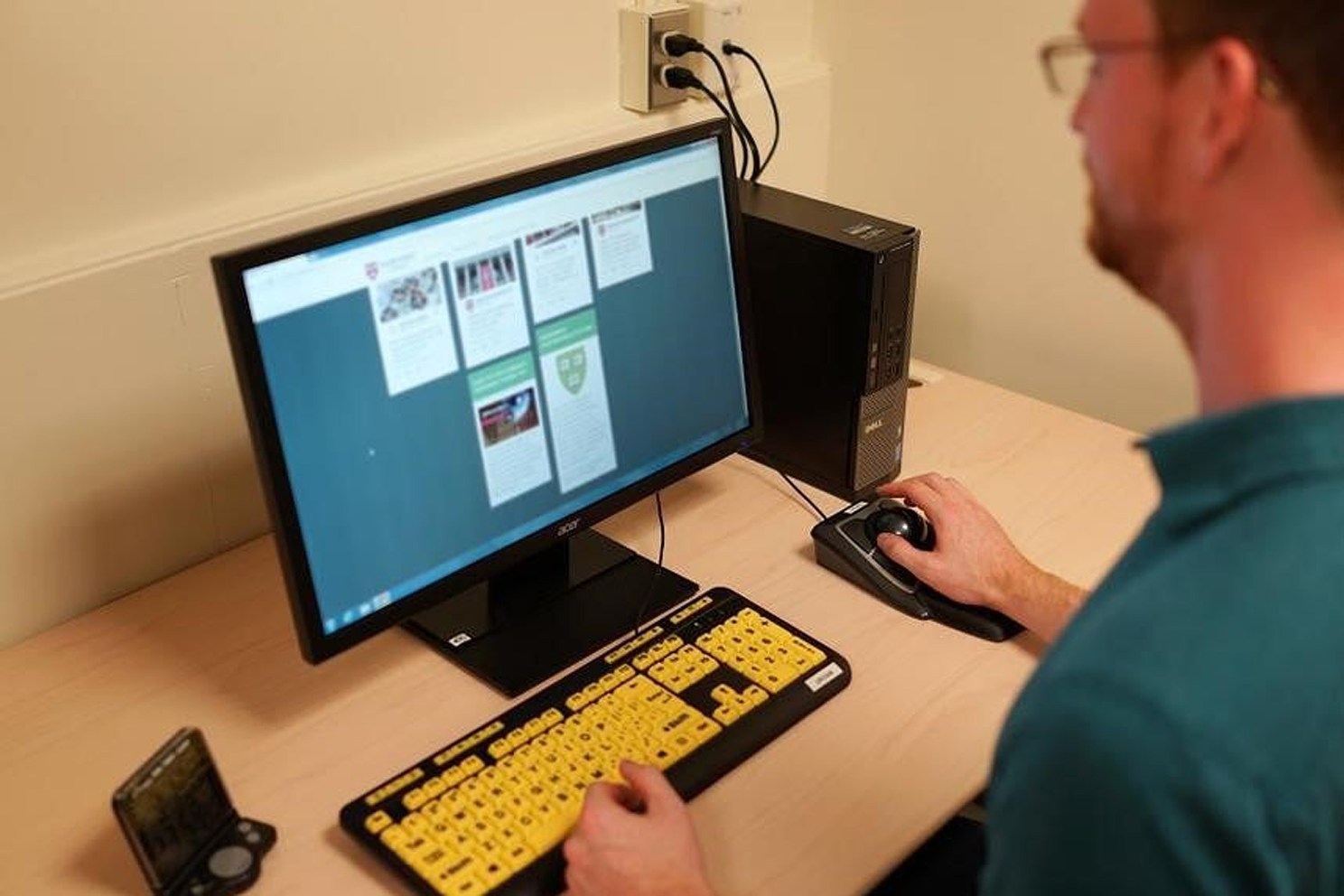Harvard Library’s User Research Center improves accessibility using student feedback

A student in the URC, testing content accessibility on a computer with assistive devices.
Many aspects of education in the United States today were not designed for people with disabilities. Whether it’s a video lecture without captions that deaf students are unable to learn from, or a single-color keyboard that makes typing impossible for students with low vision, just because something is available doesn’t mean it’s accessible.
When Harvard Library was given a grant to pilot a User Research Center (URC) in 2015, it was with the goal of reimagining access norms. The library has a vast array of digitized articles and books, research assistance services, and multimedia resources available, and wanted to make sure they were accessible to everyone. The URC aimed to do this not only by designing for users of different abilities, but also by asking for these users’ feedback.
Seven years later, the center is now a permanent part of Harvard Library and a leader on campus when it comes to digital accessibility.
For Amy Deschenes, Head of UX & Digital Accessibility for Harvard Library and leader of the URC team, including students with disabilities in their research has been key to the center’s success.
“User-centered design means designing and updating web content to make it as easy to access and understand as possible, based on testing by and feedback from the people who will use it,” Deschenes said. “I take the stance that user-centered design inherently includes accessibility. It is part of it, it’s not a separate thing. If you’re not testing with users who have disabilities, you’re missing a whole segment of the population; it would be like only testing with men.”
[gz_photo_layout_hanging_cap image=”337200″ caption=”Amy%20Deschenes%2C%20head%20of%20UX%20and%20digital%20accessibility%20for%20Harvard%20Library.%20″ credit=”Photo%20courtesy%20of%20Amy%20Deschenes” /]
She noted that “people with disabilities,” as defined for digital accessibility purposes, is a larger group than one might think. It can include someone with a broken wrist, a strong glasses prescription, or anything else that requires tweaking the way they work.
The URC works to incorporate a wide range of people in their surveys and test-runs of websites. The feedback they get from students with disabilities is often the most helpful, Deschenes said.
When Harvard Library was redesigning its main website in 2017, for instance, Deschenes said insights from user testing were invaluable. Things like color contrast and descriptive headings were suggested by users with disabilities but improved site experience across the board — and ensured compliance with the Harvard’s Digital Accessibility policy and the Web Content Accessibility Guidelines.
In recent years, the User Research Center has begun training library staff across repositories and departments, so web content is more likely to be created with accessibility in mind and less likely to require modifications.
Research librarian Anna Assogba, who has worked with the URC on materials for graduate student research programs, said Deschenes “helped program coordinators frame our thinking as we worked to make content accessible to all participants.”
“She has also made me more aware of tools I can use to check accessibility on my own,” Assogba said.
Deschenes also serves on Harvard’s Digital Accessibility Working Group, which leads discussions about campus policy around accessibility, and serves as a Digital Accessibility Liaison for the libraries.
When the pandemic forced universities to move online in March 2020, many schools shut down user research entirely.
The URC, however, found unexpected success in pivoting to remote work.
“I think the pandemic has shown us we can be just as successful, and in some ways more successful, doing user research and testing from home,” Deschenes said.
Student participation in URC studies has been “through the roof” since the pandemic began, Deschenes said. The URC was able to conduct more interviews over Zoom in a year than all the in-person interviews they’d conducted before 2020, and a larger percentage of these interviews were with students who have disabilities.
Some of these students noted they need new or different accommodations for classes or library services, compared to pre-pandemic, Deschenes said. But for some, a silver lining of the pandemic is that everything became accessible in a way it wasn’t before.
“A student with a mobility and visual impairment told me that remote classes are the most accessible classes he’s ever had at Harvard,” Deschenes said. “He didn’t have to ask for an accommodation for every class, and he felt virtual learning put him on more even footing with others.”
Other feedback on accessibility during remote learning has been encouraging, as well.
Kennedy School fellow Paula Briscoe said she had a positive experience with the library’s digital course reserves, thanks to the URC team.
“They helped me access an older book that I needed on short notice and worked with me to find the best digital format for me to use,” Briscoe said. “Their team is truly concerned with ensuring people are able to access material equally.”
And this is why the URC was created in the first place, Deschenes said — to enable equitable learning.
“We’re working with people who depend on the materials we’re providing for their livelihood, their research, their scholarship,” she said, “so we need to do everything possible to eliminate potential barriers that people with disabilities may face when accessing these materials.”





